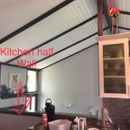Why is there condensation on my cathedral ceiling?
It’s warm outside (80 degrees) and 75 degrees in the inside thermometer. The roof is in full sun all day so it’s hot up there. The is nothing except insulation between the ceiling and roof and the condensation only forms along the beam at the peak of the roof inside.
It’s a split level home with a crawl space under the living room and the finished basement is below the upper level kitchen.
I’ve attached pictures of the space. Or there also in this link.
https://docs.google.com/document/d/161yTBWD_6da9dcwcNJj-tS6ImCO51MdU9DbEKNS1-vA
Thanks in advance for any help you can offer!!
GBA Detail Library
A collection of one thousand construction details organized by climate and house part













Replies
What makes you convinced that it's condensation, and not a roof leak?
Just a WAG: Small roof leaks can store up quite a bit of water in the roof sheathing, moisture that gets cooked out in the sunshine. With an asphalt roof there isn't sufficient vapor permeance for that moisture to dry to the outdoors, and it can be driven indoors.
The AC returns are all indicated, but where are the supply registers?
Candi,
Condensation occurs when warm, humid air contacts a cold surface. We need to know more.
1. Does your house have air conditioning?
2. Is the air conditioner operating when you observe this condensation?
3. Is there an air conditioning duct or register near the area where you see condensation?
4. What is the interior relative humidity in your home?
It doesn’t happen when it’s under 70 degrees or raining. It just started when the weTher got warm and we haven’t had much rain in the last three weeks but had a lot in March and April and there wasn’t ever water. . The water also forms on the underside of the beams not the actual roof side of the beams but the side facing down to the floor. . The registers are all in the floor. They run through the crawl space under the living room and between the basement ceiling and kitchen floor.
Candi,
You haven't answered my questions about air conditioning yet...
But it's possible to come up with a scenario. The ridge may be a little leaky and damp -- as well as poorly insulated. It's possible to imagine that moisture accumulates near the ridge, leading to damp sheathing. It's also possible that the ridge gets cold on clear nights due to night sky radiation, and that this mechanism cools the beam. Then the next morning, the sun hits the ridge and the moisture is driven inwards via inward solar vapor drive -- and the ridge beam is cool enough for condensation to occur.
Just a possible scenario. I'm not convinced it makes sense.
If you don't already have them, I'd buy a humidity meter/hygrometer and an infrared thermometer and take readings with both.